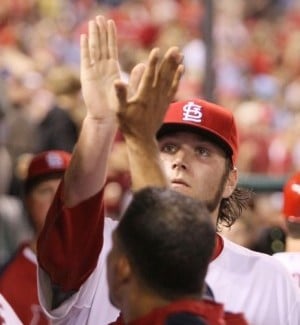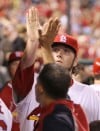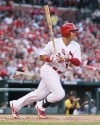The Cardinals went on another fierce bombing run
Wednesday night at Busch Stadium, assertively pounding the Pittsburgh
Pirates for 12 runs in the first three innings before showing mercy.
The final score was 12-3, running the Cardinals’ two-game total to 22 runs in their two victories over the Pirates, who may summon James Harrison, Troy Polamalu and the Pittsburgh Steelers’ defense to provide protection for today’s series finale.
After jumping on the Pirates, the Cardinals have now outscored startled opponents 60-19 in the first three innings of games this season. That isn’t baseball; that’s a mugging of a defenseless starting pitcher.
The Cardinals are scoring so early and often this season, it may take Los Angeles Kings goaltender Jonathan Quick to stop them.
The Cardinals, flying atop the NL Central at 16-8, are experiencing such high times that Rams draft pick Janoris Jenkins may try to sign with them.
So what in the name of baseball karma is going on here?
After big brother No. 5 left his happy St. Louis home in a rush for $240 million of Arte Moreno’s loot in Anaheim, the Cardinals were supposed to starve, become disoriented, slowly lose consciousness and hit about .240 as a team.
I exaggerate, sure. But it was interesting to read preseason forecastsby the national baseball literati; it’s safe to say that a downturn in offense was expected.
The Cardinals’ existence without Albert Pujols was supposed to be a lot more difficult than this. With the bodyguard gone, NL Central rivals finally had their chance to slap St. Louis around.
Right.
The Cardinals have destroyed that theory — and more than a few pitchers. Pirates righthander A.J. Burnett absorbed such a horrific beatdown Wednesday, his fastball was declared DOA at Barnes-Jewish Hospital. Burnett was violated for 12 earned runs in 22/3 innings.
Pujols’ de facto replacement, Carlos Beltran, had two homers and seven RBIs in the first three innings Wednesday. Compare that to Pujols, who had no homers and five RBIs in his first 205 innings this season.
Disneyland is down the street from the Angels’ ballpark; I’m guessing we’ll soon find Moreno boarding the "California Screamin" ride at the amusement park.
The gracious Beltran is such a class act, he’ll probably donate a few of his homers and RBIs to the Pujols Family Foundation.
The 2011 Cardinals led the National League in scoring, averaging 4.7 runs a game. Even though the Cardinals still had several formidable hitters in their lineup, it figured to be a strain to generate as much offense in 2012.
Two games into the new season’s second month, the Cardinals are leading the NL in runs per game (5.65) batting average (.290), onbase percentage (.358) and slugging percentage (.462.) They’re second in the league in homers (29) and tied for second in stolen bases.
The Cardinals have powered up and put up a lot of crooked numbers despite the annoying injuries that have limited Lance Berkman (23) and Allen Craig (four) to a combined 27 at-bats this season. What kind of damage will the Cardinals do when they have a complete collection of hitters?
There are a lot of reasons for this smashmouth offense:
Rafael Furcal has a leadoff onbase percentage of .389, which puts him among the best No. 1 hitters in reaching base.
The irrepressible Jon Jay, one of the most underrated center fielders in baseball, is batting .429 and slugging .556. Jay must be the ballplayer that Tony Rasmus always wanted.
Matt Holliday has officially heated up, batting .333 with three homers and 13 RBIs in his last 12 games.
The smooth Beltran, signed to a reasonable two-year deal, has been everything the Cardinals hoped for. He has seven homers, 18 RBIs and five steals, has scored 20 runs and is reaching base on 40 percent of his plate appearances.
Two words: David Freese. Do we need to say more than that? OK, then. Freese leads MLB third basemen in RBIs and is second in batting average and slugging.
Catcher Yadier Molina already owns the undisputed title as baseball’s best defensive catcher. Now he’s evolving into one of the best-hitting catchers in the game. Since the start of last season Molina has the most doubles among catchers and is second in slugging. In 2012, he’s off to a line-drive smoking start that includes four homers, 15 RBIs and a .318 batting average.
Rookie manager Mike Matheny is pushing his men to run, and lo and behold the Cardinals have stolen 21 bases in 26 attempts this season. Tuesday night the Cardinals pulled off an improbable double steal with the slow Molina as the lead runner and the speed-challenged Craig as the trailer. That’s some exacta.
And what about the vacated position of first base? The Cardinals wouldn’t match the massive numbers provided by Pujols over the previous 11 seasons. But with Berkman missing considerable time with a strained calf, rookie Matt Carpenter (14 RBIs, nine extra-base hits) has filled in admirably.
Through Tuesday, the Cardinals had gotten 14 RBIs, a .310 batting average, a .408 onbase percentage and a .500 slugging percentage from their first basemen. And this offense is being supplied at a fraction of the cost of the Angels’ investment in Albert Who.
If you spot Cardinals Chairman Bill DeWitt Jr. and GM John Mozeliak breaking into "The Dougie" dance, you’ll know why.
The final score was 12-3, running the Cardinals’ two-game total to 22 runs in their two victories over the Pirates, who may summon James Harrison, Troy Polamalu and the Pittsburgh Steelers’ defense to provide protection for today’s series finale.
After jumping on the Pirates, the Cardinals have now outscored startled opponents 60-19 in the first three innings of games this season. That isn’t baseball; that’s a mugging of a defenseless starting pitcher.
The Cardinals are scoring so early and often this season, it may take Los Angeles Kings goaltender Jonathan Quick to stop them.
The Cardinals, flying atop the NL Central at 16-8, are experiencing such high times that Rams draft pick Janoris Jenkins may try to sign with them.
So what in the name of baseball karma is going on here?
After big brother No. 5 left his happy St. Louis home in a rush for $240 million of Arte Moreno’s loot in Anaheim, the Cardinals were supposed to starve, become disoriented, slowly lose consciousness and hit about .240 as a team.
I exaggerate, sure. But it was interesting to read preseason forecastsby the national baseball literati; it’s safe to say that a downturn in offense was expected.
The Cardinals’ existence without Albert Pujols was supposed to be a lot more difficult than this. With the bodyguard gone, NL Central rivals finally had their chance to slap St. Louis around.
Right.
The Cardinals have destroyed that theory — and more than a few pitchers. Pirates righthander A.J. Burnett absorbed such a horrific beatdown Wednesday, his fastball was declared DOA at Barnes-Jewish Hospital. Burnett was violated for 12 earned runs in 22/3 innings.
Pujols’ de facto replacement, Carlos Beltran, had two homers and seven RBIs in the first three innings Wednesday. Compare that to Pujols, who had no homers and five RBIs in his first 205 innings this season.
Disneyland is down the street from the Angels’ ballpark; I’m guessing we’ll soon find Moreno boarding the "California Screamin" ride at the amusement park.
The gracious Beltran is such a class act, he’ll probably donate a few of his homers and RBIs to the Pujols Family Foundation.
The 2011 Cardinals led the National League in scoring, averaging 4.7 runs a game. Even though the Cardinals still had several formidable hitters in their lineup, it figured to be a strain to generate as much offense in 2012.
Two games into the new season’s second month, the Cardinals are leading the NL in runs per game (5.65) batting average (.290), onbase percentage (.358) and slugging percentage (.462.) They’re second in the league in homers (29) and tied for second in stolen bases.
The Cardinals have powered up and put up a lot of crooked numbers despite the annoying injuries that have limited Lance Berkman (23) and Allen Craig (four) to a combined 27 at-bats this season. What kind of damage will the Cardinals do when they have a complete collection of hitters?
There are a lot of reasons for this smashmouth offense:
Rafael Furcal has a leadoff onbase percentage of .389, which puts him among the best No. 1 hitters in reaching base.
The irrepressible Jon Jay, one of the most underrated center fielders in baseball, is batting .429 and slugging .556. Jay must be the ballplayer that Tony Rasmus always wanted.
Matt Holliday has officially heated up, batting .333 with three homers and 13 RBIs in his last 12 games.
The smooth Beltran, signed to a reasonable two-year deal, has been everything the Cardinals hoped for. He has seven homers, 18 RBIs and five steals, has scored 20 runs and is reaching base on 40 percent of his plate appearances.
Two words: David Freese. Do we need to say more than that? OK, then. Freese leads MLB third basemen in RBIs and is second in batting average and slugging.
Catcher Yadier Molina already owns the undisputed title as baseball’s best defensive catcher. Now he’s evolving into one of the best-hitting catchers in the game. Since the start of last season Molina has the most doubles among catchers and is second in slugging. In 2012, he’s off to a line-drive smoking start that includes four homers, 15 RBIs and a .318 batting average.
Rookie manager Mike Matheny is pushing his men to run, and lo and behold the Cardinals have stolen 21 bases in 26 attempts this season. Tuesday night the Cardinals pulled off an improbable double steal with the slow Molina as the lead runner and the speed-challenged Craig as the trailer. That’s some exacta.
And what about the vacated position of first base? The Cardinals wouldn’t match the massive numbers provided by Pujols over the previous 11 seasons. But with Berkman missing considerable time with a strained calf, rookie Matt Carpenter (14 RBIs, nine extra-base hits) has filled in admirably.
Through Tuesday, the Cardinals had gotten 14 RBIs, a .310 batting average, a .408 onbase percentage and a .500 slugging percentage from their first basemen. And this offense is being supplied at a fraction of the cost of the Angels’ investment in Albert Who.
If you spot Cardinals Chairman Bill DeWitt Jr. and GM John Mozeliak breaking into "The Dougie" dance, you’ll know why.





